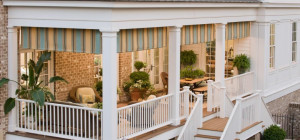 As devastating as the term “roof leak” sounds, there are several ways to prevent or spot warning signs as fast as possible and resolve a problem at a minimal cost.
As devastating as the term “roof leak” sounds, there are several ways to prevent or spot warning signs as fast as possible and resolve a problem at a minimal cost.
Leaping ahead, some roof leaks’ causes can be tricky to determine without consulting roof leak specialists but being aware of potential problems and warning signs can help you save money and eliminate stress: a timely minor repair sounds better than an extensive overhaul.
10 Most Typical Causes of Roof Leaks
Speaking point-blank, no one plans to spend time fetching drip buckets and money on grand roof repairs.
In many cases, knowing the frequently encountered causes of roof leaks can stave off the potential damage or minimize the consequences.
- Aging & wear out. As with almost anything, constructions and roofing materials have limited lifespan and endurance. Additionally, the climate and harsh weather conditions might influence longevity, making it shorter.
- Missing or cracked slates or tiles. If you look up at the roof, missing shingles are usually noticeable. Heavy rain or strong wind can be the cause. If a heavy tree branch falls on the roof, you should inspect the roof thoroughly for possible cracks. The same inspection on the annual basis is recommended anyway, even though the weather conditions are mild in your region. The earlier you notice the problem, the easier and less costly the repair work will be.
- Improperly installed or damaged flashings. They are vital for a roof to be protected from the penetration of water and pests. Flashings are usually installed along the joints, where sections meet, for example, around chimneys or skylights. Any cracks that might appear as a result of aging or temperature fluctuations can lead to roof leaks and require immediate repairs.
- Choked gutters. A well-functioning guttering system is crucial for a secure and trouble-free roof. When clogged, gutters don’t function properly and leak. It is much easier to prevent clogging by regular inspection for debris, dry leaves, etc. Once the gutters are cleaned, test the system by pouring water. If the problem persists, contact a trustworthy contractor to identify the cause of roof leaks in your house.
- Improperly installed skylights. Pretty easy to spot, roof leaks from skylights need urgent attention. In most cases, the cause is the damaged flashing or sealing around the roof window, which can be due to the incorrect installation of the skylight.
- Damaged chimney. Given that the chimney had functioned properly before you discovered roof leaks, the issue might be related to the tear and wear of mortar or flashing around the chimney. Harsh weather conditions and thermal shock can shorten the lifespan of construction materials; thus, regular checks and maintenance can prevent chimney malfunction and leakage. Anyways, chimney repairs require certain qualifications and skills, as well as specialized tools. Do not experiment on your own and contact pros to ensure that the works are executed properly and your home is safe and sound.
- Roof vents. Vital for preventing condensation in the loft, vents are responsible for taking the warm air with excess moisture out. Roof leaks can be caused by worn sealing or cracked flashing around the vents or vents being clogged up. Without proper ventilation, moisture can build up in the loft space and drip down.
- Improper valley sealing. Roof valleys, joint areas of roof sections, are weak points prone to leakage. Damaged or improperly installed flashings around roof valleys are the common reason for leaks. Damp spots along valleys are indicative of potential problems in this part of your roof.
- Condensate. This is a crucial aspect to take care of. When ignored, condensation can cause a variety of problems, including roof leaks and mold infestation. Typically, fast cooling of warm air in the attics (also known as the loft space) leads to the formation of condensate. By time moisture is built up. You may notice water drops on the loft floor and fust. On first signs, contact a reliable contractor to determine the cause, fix the problem, and check for mildew infestation. In fact, well-thought and professionally installed roof ventilation and/or loft insulation can prevent condensation development.
- Debris. Debris buildups, such as leaves, spider nets, pine needles, or twigs, prevent unrestricted water runoff and may result in damaged roof sealing, cracked flashing or roof tiles, rotten stuff, and mold growth leading to leaks. Keep the roof clean and regularly trim tree branches so that they do not hang loose over the roof.
How & When Should You Repair the Roof?
Let’s begin with “When”: as soon as you spot that your roof leaks. The faster you locate a leakage and figure out its causes, the lower your financial and time investments will be. Alternatively, the more you delay, the worse the situation will develop causing additional problems and damage that might cost you a fortune compared to prompt/timely repairs.
How to Repair Roof Leaks
With proper qualifications, skills, and experience in construction, you can probably fix some minor issues. However, DIY repairs are risky for the majority of homeowners with no expertise in this field. Incorrect material choices and wrong techniques can lead to further damage and higher costs let alone the safety of your family.
Hence, hiring certified roof leak specialists is the optimal solution:
- Besides being fully-qualified, pros are also fully equipped for executing repair works. Apart from construction tools, professionals have dehumidifiers and IR mold detectors that are crucial for drying the construction and preventing mold growth.
- A certified contractor has the necessary expertise to carry out a detailed inspection of your roof before the restoration work. This is particularly important for revealing several potential reasons for roof leaks. For instance, the unnoticed cracked tile can cause leakage soon after the condensation issue has been fixed. Naturally, no one wants to pay twice.
The rule of thumb says that regular roof inspection and maintenance conducted by certified pros can prevent leakage and save you time, money, and the nervous system.







